Belarus state media botch reporting on a botched abduction
How Lukashenka’s media apparatus mishandled a
Belarus state media botch reporting on a botched abduction
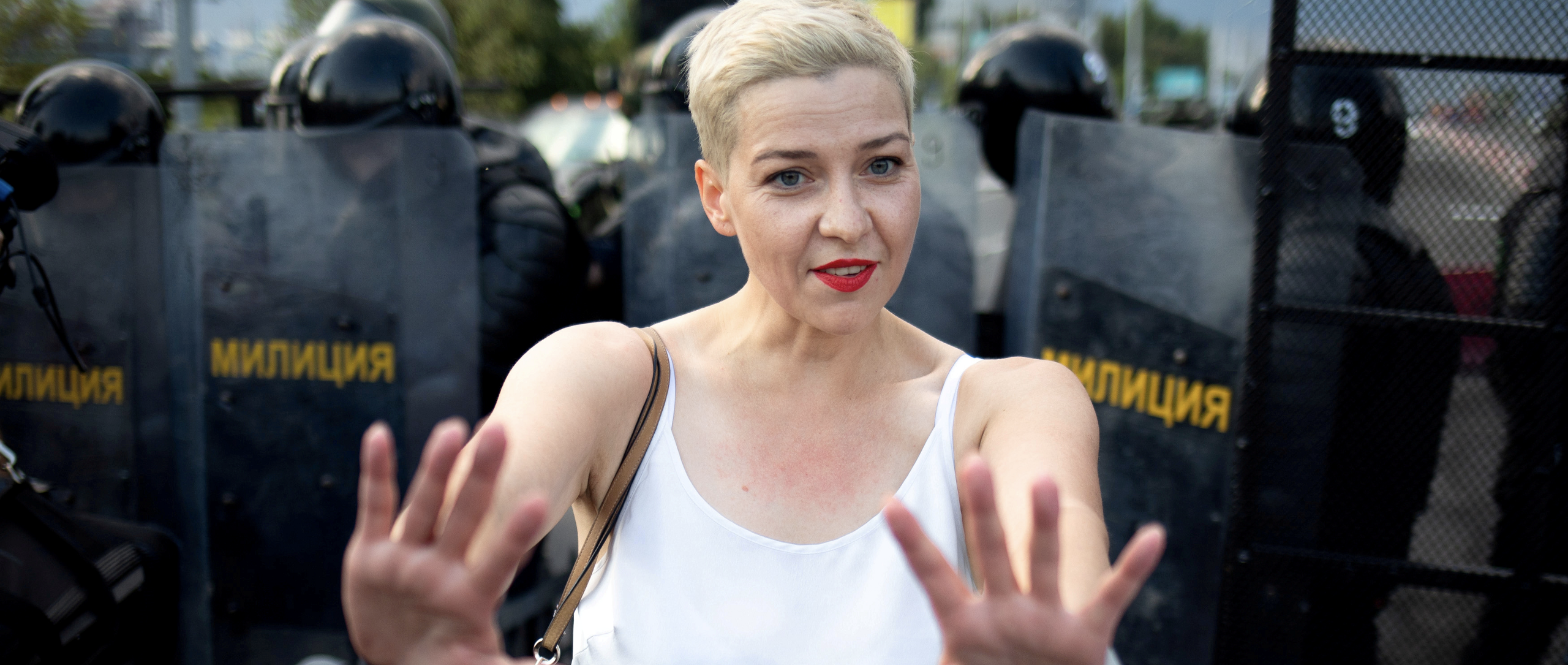
How Lukashenka’s media apparatus mishandled a staged escape of three Belarus opposition leaders when things did not go as planned
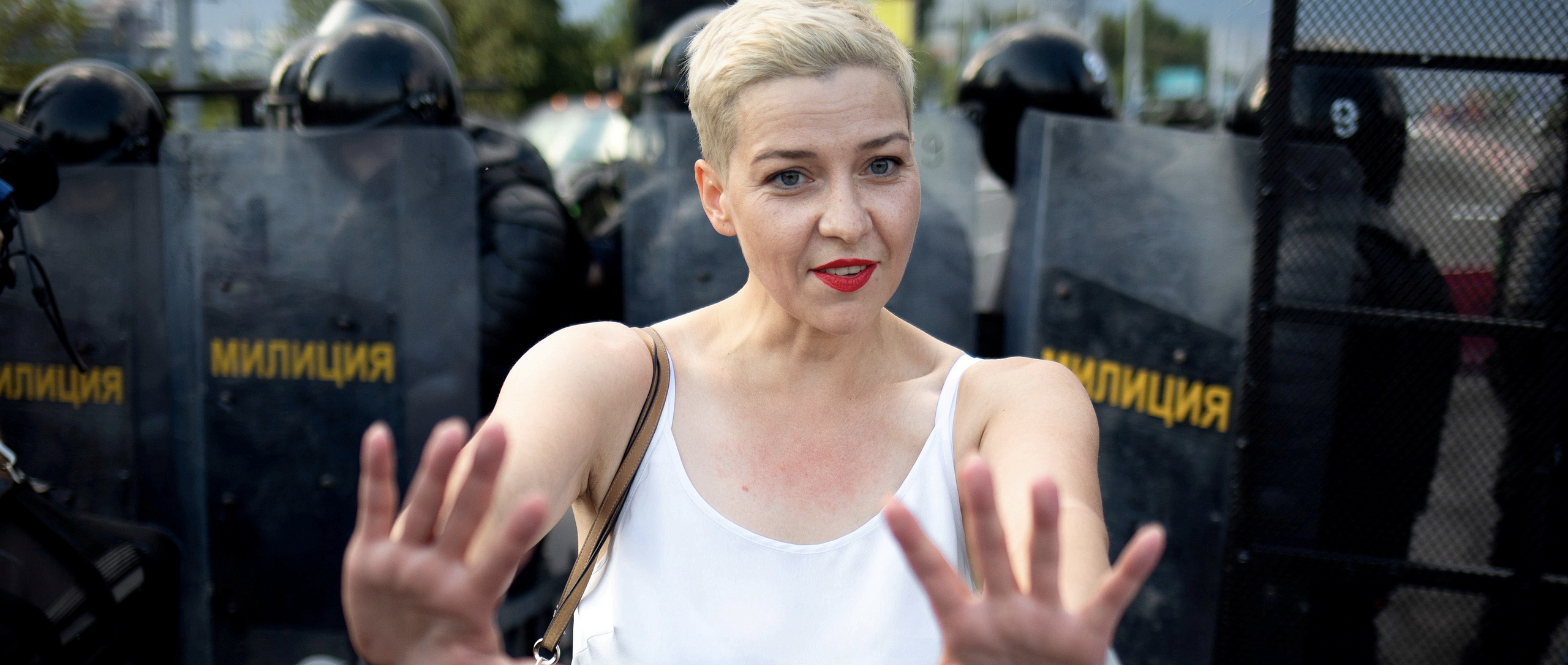
After a foiled abduction of three Belarusian opposition members, Belarus state-owned media outlets stuck to the official version of events, despite mounting evidence of inconsistencies in the story.
The official version of events from Belarusian authorities claimed that three members of the Belarus Coordination Council for peaceful power transfer, Anton Rodnenkov, Ivan Kravtsov, and Maria Kolesnikova, had attempted to illegally flee Belarus for Ukraine but were stopped at the border and arrested. Eyewitness reports and accounts from the opposition activists, however, suggests that the three were abducted by masked security agents and forced to participate in a staged escape attempt — which was foiled when Kolesnikova destroyed her passport, which she needed to enter Ukraine.
The state-owned media’s failure to adjust their reporting after Rodnenkov and Kravtsov unexpectedly went live with a press conference about their kidnapping demonstrated that the official account of the operation was likely planned ahead of time, with little room for error or adjustment if the abduction did not turn out exactly as planned.
The Coordination Council for lawful power transfer in Belarus was established on August 18, on the initiative of Sviatlana Tsikhanouskaya, the opposition presidential candidate. Following the elections, allegations of electoral fraud have led to ongoing protests in the country. The Coordination Council is considered to be the institution that represents the will of those opposing election results and President Alyaksandr Lukashenka himself. On August 20, the Belarus chief prosecutor launched a criminal case against the Coordination Council.
The kidnapping
Open-source reporting on the alleged kidnapping of Kolesnikova, Kravtsov, and Rodnenkov helps reconstruct some of what happened.
On Monday, September 7, 2020, council member Maria Kolesnikova was reportedly “detained” by unknown men. Later, the Coordination Council announced on Telegram that in addition to Kolesnikova, two other members — Anton Rodnenkov and Ivan Kravtsov — had been “kidnapped by unknown men in the center of Minsk.” The next morning, pro-Lukashenka media and Telegram channels reported that all three had attempted to leave Belarus for Ukraine. Kravtsov and Rodnenkov managed to leave, but Kolesnikova was detained. Later, the State Border Committee of the Republic of Belarus and Lukashenka provided a different version of events that did not match with what State Border Guard Service of Ukraine and Anton Garaschenko, the Deputy Minister of Internal Affairs in Ukraine, had stated about the incident. Later, at about 5 p.m. local time, the Coordination Council announced on its Telegram channel that it had established contact with Kravtsov and Rodnenkov. Both held press conference in Ukraine that shed light on what had happened to them and Kolesnikova.
Belarus authorities never admitted to being involved with the disappearance of the three members of the Coordination Council. The first report about Kolesnikova’s kidnapping was based on an anonymous eyewitness account published on independent Belarus media outlet Tut.by. The witness, identified by the first name Anastasia, claimed that she saw “men in civilian clothes and masks force Maria into a micro bus.”

The kidnapping reportedly took place by the National Arts Museum in Minsk at about 10:05 a.m. local time. Later, Tut.by posted a video by another witness who was passing by the museum and caught the alleged kidnapping on video. The video indeed showed a dark microbus by the National Arts Museum at 10:02 in the morning, but it was impossible to identify who entered the bus.

According to Rodninkov’s account, he and Kravtsov went to check on Kolesnikova at her apartment after receiving media inquiries about her alleged detention. Her location app showed that her phone was at the apartment. Rodninkov claimed that on their way back, “in an arch between the building at Nezavisimosti Avenue, a minibus arrived, [..] unknown men came out of the bus and pushed us in to it.”
A failed plan
Kravtsov claimed during the press conference that he was blackmailed with “criminal charges on abuse of office power” that would “result in five to 12 years in jail.” The alleged kidnapper told them that due to “Maria Kolesnikova’s deportation abroad,” it was necessary to “to deescalate situation in the country,” Kravtsov explained. “One of the options [to avoid going to jail] was that the three of us on my personal car cross the border.”
A video showing a BMW crossing the Belarus border checkpoint at 4:05 am appeared on Belarus state TV’s Telegram channel.
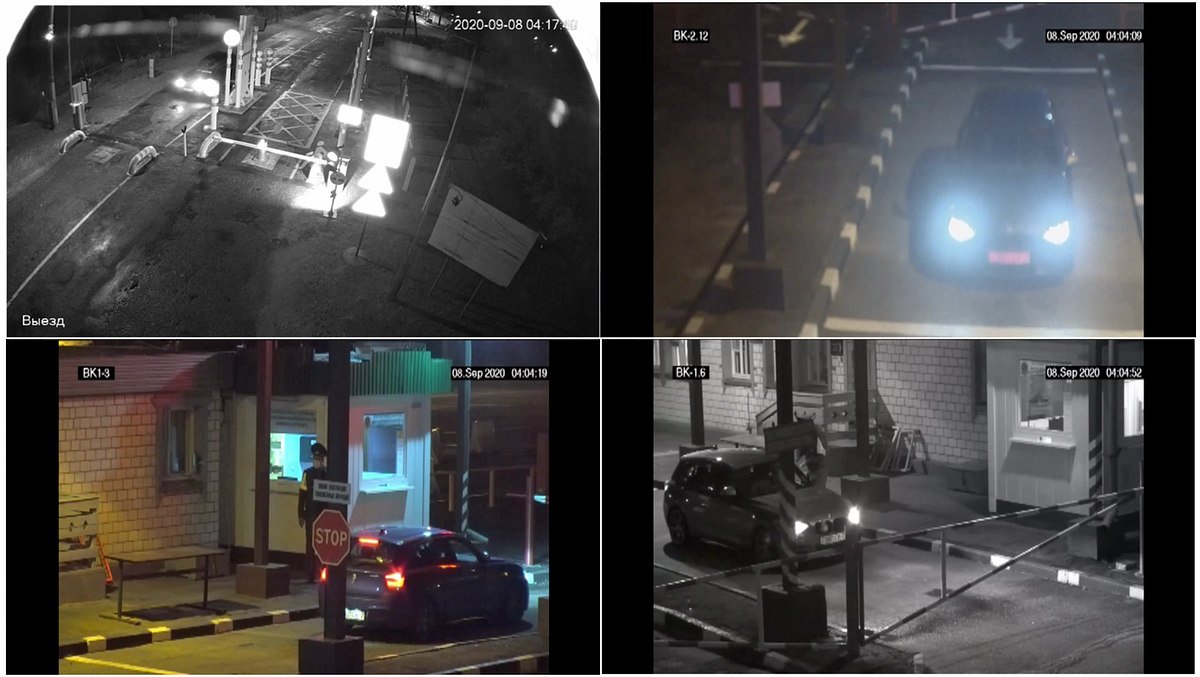
According to Kravtsov, he drove to the border with two men who had passports for all three of them:
The whole column stopped a kilometer before the border checkpoint. We changed cars, and they put me behind the wheel of my car. The car was brought by another man from Minsk. I sat in my car and two other man sat with me. They had Rodnenkov’s and Kolesnikova’s passport. We came by the Belarus checkpoint. The border guard came, looked at the passports… looked at Kolesnikova’s passport and said yes, Maria, thank you. He looked… at Rodnenkov’s passport, said yes, you may go, looked at my passport, said — all the best. So special forces traveled as Maria Kolesnikova and Anton Rodninkov, and the border guard did not pay attention to that.
This episode was most likely caught on video. The video itself did not show any struggle, but an accompanying text said that after passing the first checkpoint, the car accelerated and someone pushed Kolesnikova out of the car.
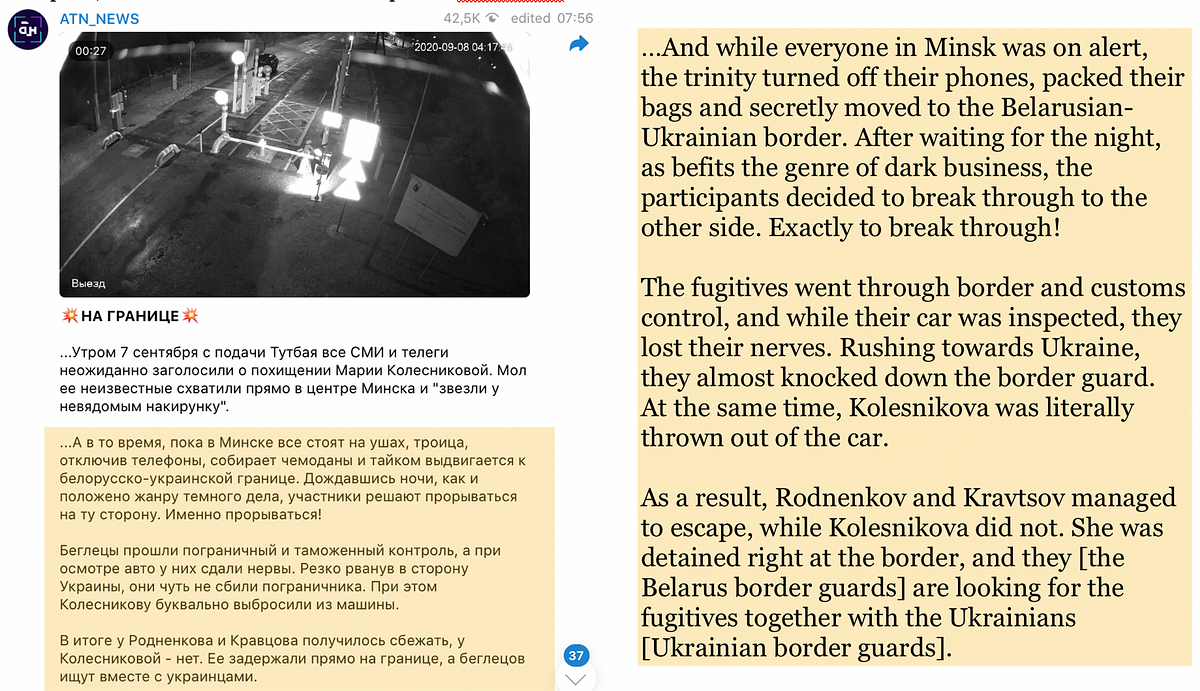
This version of events corresponded with the version released by the State Border Committee of the Republic of Belarus on Telegram later in the morning.
During the press conference, Rodnenkov described what happened:
At 22:30 they put me in a dark minibus. Later they transferred me to a black SUV BMW X6. I was in the middle on the back seat. On the sides sat two big men with no insignia in black masks and hats. Two such men sat in front too. At first, I was wearing a dark bag on my head. In 20 minutes they let me take it off, so I could see how we drove. There were four to six cars in the column. One of the cars was Ivan Kravtsov’s. There were two minibuses and some other cars. We arrived at the Belarus border checkpoint. I noticed that we passed it without stopping. So I did not exit the black BMW, and the car at full speed entered the neutral territory.
All the cars stopped in the neutral territory and then they offered me to go and sit in Ivan’s BMW. I went, Ivan sat there, I sat next to him in the driver’s seat. I noticed our passports, because before the passports were taken from us. Then Maria Kolesnikova appeared. They were bringing her. It was quite loud. It was clear that she was forced, that she was resisting. They forced her into the back seat, the doors were locked so they could not be opened from within. They pushed her in and closed the doors. She could not exit, and shouted that she will not go anywhere.
As soon as she noticed her passport in front of her, she took it and tore it into many, many small pieces. She shook these pieces in her hands and threw them out of the window toward the unknown men who surrounded the car. Then she climbed out of the back window from the back seat and went back to the Belarus border checkpoint.
This episode explains why “Kolesnikova was thrown out of the car,” according to the Belarus official version. The detail that she apparently tore her passport apart was first reported at about 10 a.m. local time in the Ukrainian media outlet Interfax Ukraina, which cited an anonymous source. Kolesnikova later confirmed the fact that she destroyed her passport via her lawyer.
As far as the description of the accelerating car, Kravtsov said:
My task was to accelerate the car and speed toward the Ukrainian border checkpoint as soon as Maria Kolesnikova got in the car. I failed at this task, unfortunately. I did not drive fast. I let Maria Kolesnikova leave the car. [..] [Maria] went toward the Belarus side of the border, I think the state officials took her back on a minibus [which brought her to the border]. Then there was a pause. Everyone understood that she cannot go to Ukraine without a passport. They cannot force her, and we did not proactively cooperate. I guess they decided to detain us again. They started to lure us in, asked to drive a little bit back, go off the road. The bus with Maria Kolesnikava tried to block us. At one moment, the same men who I talked with before came and started to talk with me, and then I noticed that all of a sudden from the woods another minibus drove across the road. We understood that the situation comes together unpleasant, so I accelerated and we elegantly drove off the road quickly… and drove away. [..] they chased us, we saw and quickly drew closer to the [Ukrainian] checkpoint. There the nice and understanding Ukrainian border guards met us.
The Belarus authorities’ official account stated that “Anton Rodnenkov and Ivan Kravtsov, as part of mutual collaboration [between Belarussian and Ukrainian border control], were detained by the neighboring side on the territory of Ukraine.” The Ukrainian State Border Guard service refuted the allegation that Kravtsov and Rodnenkov had been detained.
Later, President Lukashenka commented that all three had “fled.” He said the following to several Kremlin journalists:
I was just informed that she and two, not friends, not drivers, not relatives, relatives, today were fleeing to Ukraine. All documents were prepared, they showed the passport at our border checkpoint, the border guards and customs officers let them through. Then there is a neutral territory and Ukrainian checkpoint. But in-between those checkpoints there are eight or nine kilometers. [..] On that territory on our side we enhanced the military presence, so they got stopped. They accelerated their car. She [Kolesnikova] got thrown out on the go. There were three — who else threw her out? Our border guards detained her, naturally, as it needs to be done, I say as a former border guard, and took her to the border post. The rest across the border through the Ukrainian post… the Ukrainians, as far as I know, detained them, and we are now negotiating to get them back.
Lukashenka made it sound as if the three wanted to leave Belarus and go to Kolesnikova’s sister’s house in Ukraine. Rodnenkov explained during the press conference that Ukraine was chosen as the destination because neither Rodninkov nor Kravtsov could go to Lithuania or Poland, as they did not have visas. He also said that in the car there were documents prepared for them, including two airline tickets to Turkey for him and Kravtsov, and one ticket to Vienna and then to Munich, apparently for Kolesnikova.
The press coverage
Belarus state-owned news agency BELTA ignored Kravtsov’s and Rodninkov’s version of the story. The state-owned television channel aired its news story at about 9 p.m. on September 8. By that time the version by Rodninkov and Kravtsov was public, but the channel stuck to its existing story, ignoring the developments as well as official statements by Ukrainian officials. Pro-Lukashenko TV channel ONT did the same. In an evening story, the ONT anchor challenged the claim that Kolesnikova had torn apart her passport.
The pro-government Telegram channel Zheltye Slivy, however, wrote about the events at the border, while another channel, ATN_NEWS, released the video from the border control’s CCTV cameras about three hours before the Belarus State Border Committee published its statement on Telegram. This suggests that the media was prepared in advance to disseminate the story about the alleged escape of the three members of the Coordination Council.

Making light of what happened
After Rodninkov’s and Kravtsov’s press conference, pro-Lukashenka Telegram channels started releasing memes about the alleged escape which acknowledged the detail that Kolesnikova had destroyed her passport.
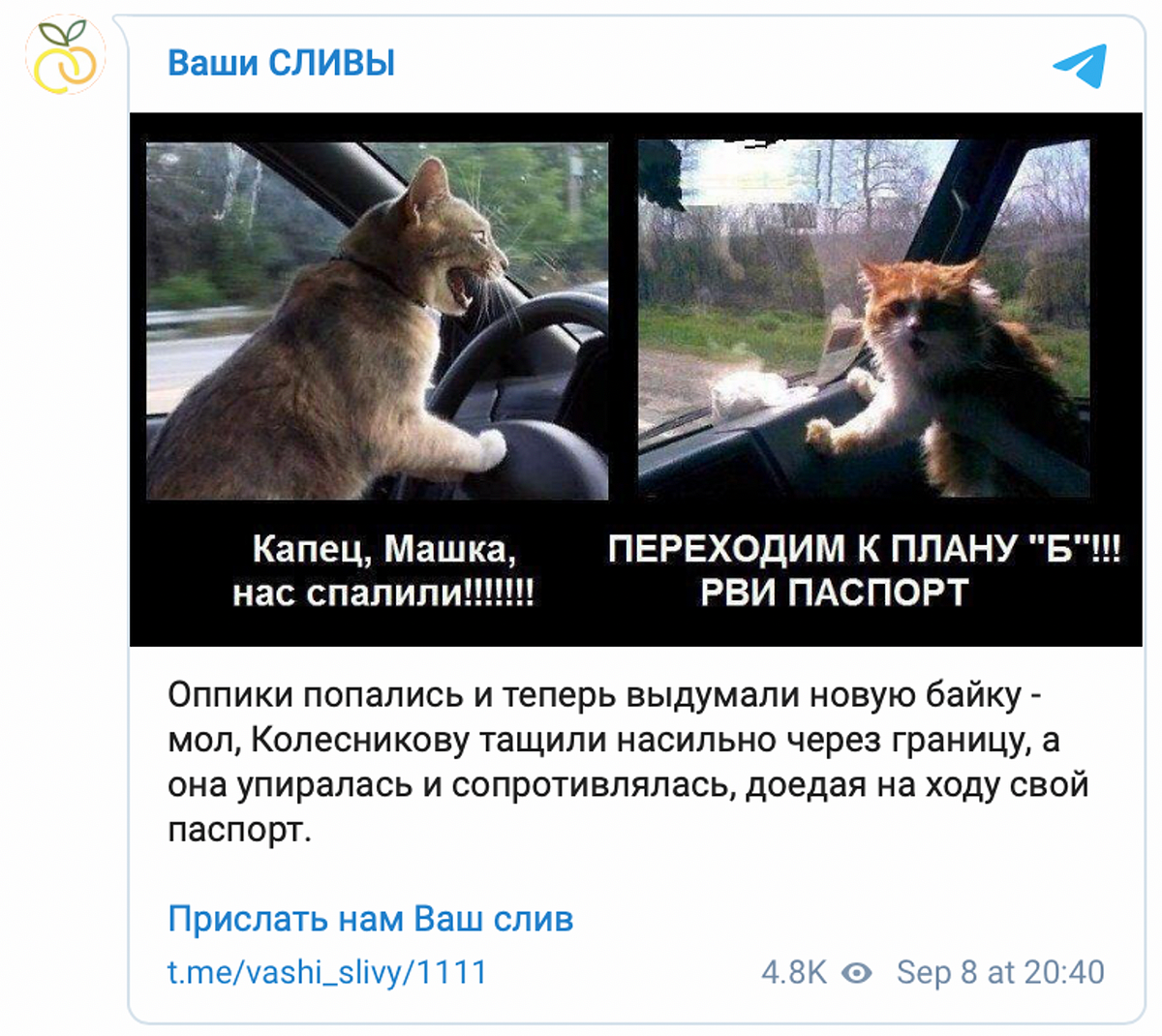
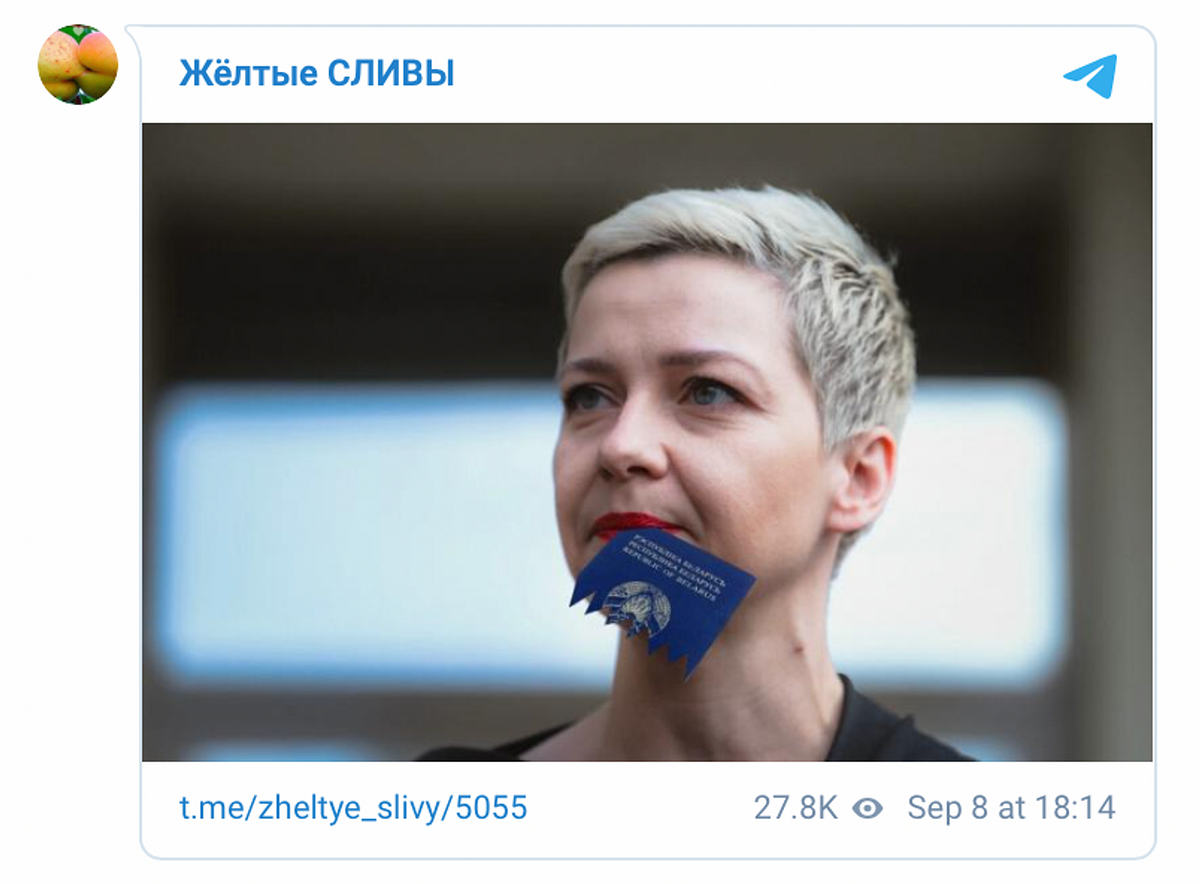
Faced with what appeared to amount to a botched kidnapping operation, the Belarus state-owned media apparatus stuck to the official version of events while simultaneously resorting to humor to distract the audience from suspicious details.
Nika Aleksejeva is a Research Associate, Baltics, with the Digital Forensic Research Lab.
Follow along for more in-depth analysis from our #DigitalSherlocks.

